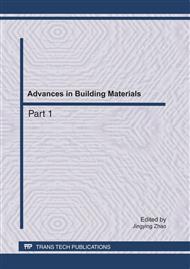p.3
p.8
p.13
p.19
p.24
p.29
p.33
p.38
p.43
Impact Study on Mechanical Properties of Recycled Concrete Based on Waste Brick Aggregates
Abstract:
Through the experiments of recycling bricks from building waste, the paper studies the mechanical properties and the influence factors of recycled concrete which is based on waste brick aggregates. Using the method of gravels substituted by brick aggregates with the same volume, the optimal mechanical properties can be obtained through adjusting the aggregate contents of different recycled brick sizes, the mix proportion and water consumption of recycled materials. The results of experiments show that there are some key indexes including the bibulous rate of brick aggregates, particle gradations and water consumption, and the optimal size of the brick aggregates ranges from 9.5 mm to 19 mm, and the mechanical properties of recycled concrete are slightly below the referenced concrete by lots of experiments. Therefore, building waste bricks recycled concrete are a kind of very good, sustainable and energy-saving building materials.
Info:
Periodical:
Pages:
24-28
Citation:
Online since:
May 2011
Authors:
Price:
Сopyright:
© 2011 Trans Tech Publications Ltd. All Rights Reserved
Share:
Citation:


